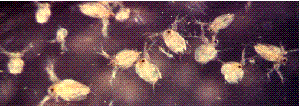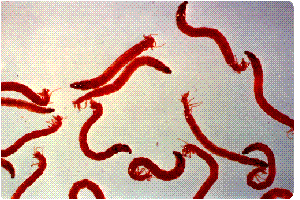

THE BASICS OF FISHKEEPING
Feeding the Fish

By choosing the right kind of aquarium, equipment, plants,
decorations and optional accessories we lay the basis for
the healthy conditions in our fish tanks. It is up to us
the hobbyist to set up the closed environment in such a way
that our fish can thrive.
This section will cover all the basics of setting up your
aquarium in order to reach your goal.
Navigation Console


Return to the Navigation Console
FOODS AND FEEDING
Perhaps no single fact about a fish we intend to keep is more important than the knowledge of its feeding habits. Given proper temperature and water conditions, the health and growth of our fish will depend almost entirely on how and what we feed them. There are three different diet types, and all fish will fall into one of these types.
- Carnivores
Need fish or meat in their diet: i.e. the predators.
- Herbivores
Plant eaters or algae grazers.
- Omnivores
These fish are both Carnivorous and Herbivorous.
This section will try to give some explanations and suggestions on how to keep our wet friends happy and healthy.
Classification of food
The food we give our fish can be divided into four basic food types:
- Flake food and its relatives.
- Freeze dried.
- Vegetable food.
- Live or frozen food.
All food starts out as some sort of "live" material and through whatever processing it goes through becomes the food we feed our fish. I will define each type here.
Flakes and other dry food
You can buy dry fish food that is made up of animal or plant matter as well as every combination needed at any fish store. Dry food is a good basic staple. Store dry food in a cool dry place and don't use it after a few months as they tend to lose their nutrients and vitamin content over time. Dry food comes in different forms.
- Flakes
These are lite and float on the top of the water surface and they sink to the bottom very slowly. Flake food comes in many varieties and sizes depending on the fish you have. This is the most common type of food available. Its best use is for fish that eat at the surface or in the open water.
- Tablets
Are a sinking type of food that is good for our overlooked bottom dwelling fish.
- Pellets
These are either floating or sinking stick shaped and
are used for our fish that like a lot of substance in their meals.
Freeze dried food.
Fresh food is quickly frozen and then put under a very
high vacuum. The water vaporizes and is removed. Since the
food was frozen so quickly many of the nutrients and vitamins remain intact. The most popular varieties are Tubiflex worms and Krill.
Vegetable food
Many fish, especially some Cichlids and the Lori Cats
have to get some sort of vegetable food. You can buy a dry vegetable flake or pellet food at the pet store or give your fish fresh ones. Suitable vegetables include spinach and leafy forms of lettuce (not Iceberg) Bits of Potatoes and Cole crops can also be given. All leftover fresh vegetable food must be removed after a couple of days to prevent decay and water pollution.
Live and frozen food
Today, there is little difference in the quality of live and frozen food products. There is no difference in the nutritional value between them. Some fish and most fry still demand that their food is still moving before they eat it.
Frozen food
Aquarium stores sell frozen food in the shape of flat bars
or ice cubes. You can store the food in your freezer for
long periods of time without loss of nutritional value.
When you wish to feed some either break of a chunk or pop
out a cube and place it in a small glass filled with
aquarium water. Let the temperature almost equalize and
then spread the food across the surface.
Live food animals
The most common live food animals are Brine shrimp and
Tubiflex worms. They are available at pet stores from time
to time and should be bought whenever you can obtain them.
I will go through other live foods that are sometimes
available. Small crustaceans contain Carotenoids, which
bring out the natural Red coloration in fish.
- Daphnia

A small Crustacean, that once was the mainstay of live
food. They range in size to about 1/8" long. Almost all
fish love this food and will gorge themselves with it. The
hard shell also provides a good source of roughage.
- Mosquito larvae
Red, Black and white Mosquito larvae can be used as
live food They are suitable for all fish except for the
very small.
- Bloodworms

These so called worms are really the larvae of a midge.
They are blood Red in color and are about 3/4" long. They
wriggle in the water in a figure eight pattern. One of my
favorite foods, frozen or live.
- Tubiflex worms
These worms live on the banks of sewage ponds and
are found for sale from time to time. To clean them and
keep them alive, they must be put in a pan and left under a
gentle stream of cold water. Do not feed large amounts of
this food as they can establish a colony in your gravel.
Given in small quantities they are an excellent food
source.
- Earthworms
What better food can be found as easily as the worm?
Just dig them from your yard or purchase them from a bait
shop. Worms can be feed whole to the large fish such as
Cichlids or chopped for smaller fish. Earthworms could be
considered the ideal live food, perfect for conditioning
your fish for breeding.
- Fruit flies
Small flies that we all grew in High school,
Drosophilia are an excellent fish food. When placed in the
tank they "swim" on the surface making them great for the
insect catching fish we keep.
- Brine Shrimp
The most common of the live foods available. Brine
shrimp are also one of the best foods for our fish. When
purchased they are usually placed in a bag, you must remove
the water they are in and rinse with clean water before
feeding. I have never seen a fish that did not relish the
introduction of the shrimp. Brine Shrimp can also be
hatched from eggs fairly easily and is a good source of
live food to feed newly hatched fry.
Vitamin Supplements
A lack of vitamins weakens the disease resistance in
fish. To add extra vitamins you can buy dried food with a
supplement included or add the supplement directly to the
tank. If you feed your fish a properly stored dry food and a
varied selection of live and frozen food, vitamin
supplements should not be needed.


to main basics page.

Email:
badman2nd@hotmail.com







